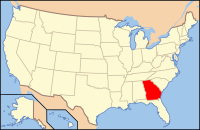Sumter County, Georgia
| Sumter County, Georgia | |
|---|---|

Sumter County Courthouse in Americus
|
|
 Location in the U.S. state of Georgia |
|
 Georgia's location in the U.S. |
|
| Founded | December 26, 1831 |
| Named for | Thomas Sumter |
| Seat | Americus |
| Largest city | Americus |
| Area | |
| • Total | 493 sq mi (1,277 km2) |
| • Land | 483 sq mi (1,251 km2) |
| • Water | 10 sq mi (26 km2), 2.0% |
| Population (est.) | |
| • (2015) | 30,779 |
| • Density | 68/sq mi (26/km²) |
| Congressional district | 2nd |
| Time zone | Eastern: UTC-5/-4 |
| Website | www |
Sumter County is a county located in the west central portion of the U.S. state of Georgia. As of the 2010 census, the population was 32,819. The county seat is Americus. The county was created on December 26, 1831.
Sumter County is part of the Americus, GA Micropolitan Statistical Area.
Sumter County was established by an act of the state legislature on December 26, 1831, four years after the Creek Indians vacated the region when the state acquired the territory from them in the 1825 Treaty of Indian Springs. Sumter, the state's eightieth county, was created after population increases by a division of Lee County, now situated to its south. The county was named for former General and United States senator Thomas Sumter (1734–1832) of South Carolina. when the county was organized, Sumter was ninety-seven years old and the last surviving general of the American Revolution (1775–83).
Shortly thereafter, a committee chose a central site for the county seat and laid out what would become the town of Americus. Many of the county's earliest white residents acquired their land through an 1827 state land lottery. Like many other white settlers, they quickly developed their property for cotton cultivation. Since the invention of the cotton gin at the end of the 18th century, short-staple cotton was the type of choice throughout the Black Belt of the South.
The rich black soil, combined with ready market access via the Flint River (bordering the county on the east) or the Chattahoochee River (farther west), made Sumter among the state's most prosperous Black Belt counties by the 1840s and 1850s. Cotton agriculture was economically dependent on enslaved African Americans. By the 1850 census, the demographic makeup of the county had become 6,469 whites, 3,835 slaves, and 18 free people of color. By the 1860 census, there were 4,536 whites, 4,890 slaves and 2 free people of color.
...
Wikipedia
